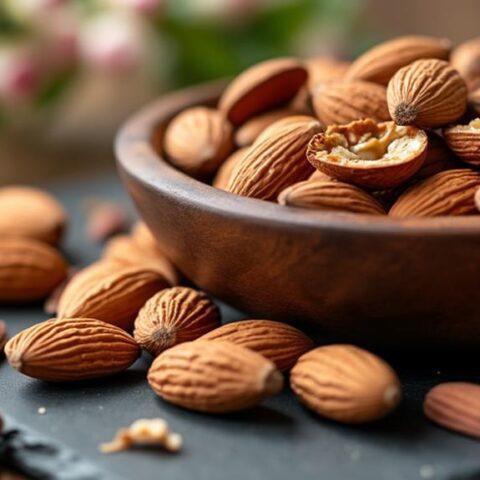
Gluten itself contains no carbohydrates, as it is purely a protein found in wheat, barley, and rye. However, most gluten-containing foods are high in carbohydrates because these proteins naturally occur in starchy grains. Many gluten-free alternatives can also be high in carbs, as they often contain rice flour or corn-based ingredients. Understanding the distinction between gluten and carbohydrates helps consumers make more informed dietary choices based on their specific health needs.
Key Takeaways
- Gluten itself is a protein that contains zero carbohydrates, though it's commonly found in high-carb foods like bread and pasta.
- Many gluten-containing foods are high in carbs because they're made from wheat, but the gluten protein isn't responsible for carbohydrate content.
- Gluten-free products often contain similar or higher carbohydrate levels because they use alternative ingredients like rice or corn flour.
- Following a gluten-free diet doesn't automatically mean consuming fewer carbohydrates, as these are separate dietary considerations.
- Low-carb dieters can consume gluten protein itself, but should avoid wheat-based products that naturally contain both gluten and carbohydrates.
Understanding Gluten as a Protein
Proteins are essential building blocks in our diet, and gluten stands as a unique example found primarily in wheat, barley, and rye. This specific protein consists of two main components that work together to give dough its characteristic elasticity and structure, enabling baked goods to maintain their shape and rise properly during baking.
While gluten itself contains no carbohydrates, it frequently appears in carbohydrate-rich foods like bread, pasta, and processed products. This association often leads to confusion about its nutritional classification.
For individuals with celiac disease or gluten sensitivity, understanding this distinction is vital, as they must follow a strict gluten-free diet to avoid health complications. The prevalence of gluten in processed foods requires careful label reading to identify and avoid this protein effectively.
The Carbohydrate Connection in Wheat Products
Wheat products contain a complex nutritional profile where carbohydrates and gluten exist independently, with the protein gluten having no direct impact on carbohydrate content.
While a slice of wheat bread typically contains around 15 grams of carbohydrates, its gluten content is separate from this measurement and serves primarily as a structural protein.
Understanding this distinction becomes vital when examining wheat-based foods, as their carbohydrate content remains consistent regardless of gluten levels, making them generally unsuitable for low-carb diets even when gluten is reduced or modified.
Wheat's Complex Carb Profile
Understanding the carbohydrate composition of grain products requires a closer look at their complex nutritional profile. In wheat products, the relationship between gluten and carbohydrates is particularly significant for those following low-carb diets. While gluten itself is a protein, its presence in wheat-based foods coincides with substantial carbohydrate content, presenting challenges for dietary goals.
| Component | Content per 100g |
|---|---|
| Total Carbs | 72g |
| Starch | Primary form |
| Added Sugars | Variable |
| Protein (Gluten) | Present |
The carbohydrate profile of wheat extends beyond simple sugars, encompassing complex starches that contribute to high-carb foods. When combined with additional ingredients in processed foods like pastries and cereals, the carbohydrate content increases further, making wheat products generally incompatible with low-carb dietary approaches.
Breaking Down Gluten Content
While gluten itself is a complex protein structure, its presence in foods invariably signals higher carbohydrate content due to its natural occurrence in starchy grains.
Understanding this relationship is essential for those following low-carb diets, as gluten-containing foods like wheat bread and pasta typically pack significant carbohydrate content, with a single slice of bread containing approximately 15 grams of carbs.
It's important to note that while gluten-free alternatives might seem like a solution for reducing carbohydrate intake, these products often contain similar or higher levels of carbohydrates.
Foods made with alternative ingredients such as rice or corn can still contribute substantially to daily carb totals.
For those monitoring their carbohydrate intake, the focus should be on the total carbohydrate content rather than the presence of gluten alone.
Hidden Carbs in Bread
Despite their widespread popularity in daily diets, bread products often conceal substantial amounts of carbohydrates that can challenge those pursuing low-carb lifestyles. A typical slice of wheat bread contains approximately 15 grams of carbohydrates, primarily from flour, though the gluten protein itself doesn't contribute to this count.
Those seeking gluten-free alternatives should note that these products aren't necessarily lower in carbohydrates. In fact, gluten-free breads made with alternative flours like rice or corn can contain between 15 to 25 grams of carbs per slice.
Additionally, many processed gluten-free options incorporate added sugars and starches to improve texture and taste. For individuals following low-carb diets, understanding these hidden carbohydrate sources becomes essential when making informed dietary choices, regardless of gluten content.
Common Misconceptions About Gluten and Carbs
Many people mistakenly equate gluten-free foods with low-carb options, creating widespread confusion about the relationship between gluten and carbohydrates. This misunderstanding often leads to incorrect dietary choices for those seeking to reduce their carbohydrate intake.
Common misconceptions about gluten and carbohydrates include:
- Assuming all gluten-free foods are automatically low in carbs
- Believing that removing gluten automatically reduces carbohydrate content
- Thinking gluten-containing foods are always high in carbohydrates
- Mistaking gluten-free alternatives as better choices for low-carb diets
- Confusing gluten-free diets with low-carb dietary approaches
The reality is that gluten-free foods can be just as carbohydrate-rich as their gluten-containing counterparts.
Foods like rice, quinoa, and gluten-free breads often contain significant amounts of carbohydrates, despite being free from gluten protein.
Health Implications of Gluten Consumption
Understanding the health implications of gluten consumption has become increasingly important as research reveals its diverse effects on different populations. For individuals with celiac disease, non-celiac gluten sensitivity, or wheat allergies, consuming gluten can trigger serious health problems ranging from digestive issues to nutrient deficiencies.
| Condition | Prevalence | Key Symptoms |
|---|---|---|
| Celiac Disease | 1% | Intestinal damage, malabsorption |
| Non-celiac Sensitivity | Variable | GI distress, fatigue |
| Wheat Allergy | 0.2-1% | Anaphylaxis, allergic reactions |
| General Population | Majority | No adverse effects |
| Gluten-free Diet | Growing trend | Potential weight loss, varied results |
While following a gluten-free diet is essential for those with gluten-related disorders, individuals without these conditions may not experience significant health benefits from gluten elimination.
Reading Food Labels: Gluten Vs Carb Content
Understanding nutrition labels requires careful attention to both gluten-containing ingredients and total carbohydrate content, as these two factors operate independently of each other.
While products labeled "gluten-free" may appear healthier at first glance, shoppers should examine the carbohydrate content separately, paying particular attention to total sugars and net carbs.
Consumers can identify hidden sources of gluten by looking for ingredients such as wheat starch, barley malt, or rye flour, while simultaneously evaluating whether the product aligns with their carbohydrate goals through the nutrition facts panel.
Decoding Nutrition Facts Labels
When consumers examine nutrition labels for both gluten and carbohydrate content, they must recognize these components as distinctly different dietary elements. Understanding how to interpret nutrition facts labels is essential for making informed dietary choices, particularly when following specific dietary restrictions.
- Check ingredient lists specifically for wheat, barley, and rye to identify gluten-containing products.
- Remember that gluten-free products may still have high carbohydrate levels.
- Look for total carbohydrate content separately from gluten information.
- Consider alternative flours like almond or coconut for low-carb gluten-free options.
- Compare carbohydrate content between gluten-free alternatives and traditional products.
Careful label reading reveals that gluten-free alternatives, such as rice or corn-based products, can sometimes contain more carbohydrates than their wheat-based counterparts.
This understanding helps consumers make choices that align with both their gluten sensitivity and carbohydrate intake goals.
Finding Hidden Gluten Sources
Building on the foundation of label reading, consumers face additional challenges when identifying hidden sources of gluten in their food choices.
Gluten can lurk in unexpected places, from processed meats to condiments and seasonings, making thorough label inspection essential. While gluten-free products offer alternatives, they often contain substitute ingredients that may be high in carbohydrates, such as rice flour or potato starch.
Consumers must carefully examine nutrition labels not only for gluten-containing ingredients but also for overall carbohydrate content.
Many processed foods contain hidden gluten in ingredients like modified food starch, malt flavoring, or natural flavorings. Understanding these potential sources helps individuals maintain both gluten-free and low-carb dietary requirements, ensuring they make informed choices that align with their nutritional goals.
Comparing Product Label Claims
Careful examination of product labels reveals distinct differences between gluten content and carbohydrate levels, making it essential for consumers to evaluate both components separately.
When comparing nutrition labels, shoppers should understand that gluten-free products don't automatically indicate lower carbohydrates, and vice versa.
- Always check both gluten and carbohydrate content independently on product labels
- Gluten-free breads may contain similar or higher carbohydrate levels than regular bread
- Some low-carb products might still contain gluten from wheat-based ingredients
- Alternative flours used in gluten-free products can be high in carbohydrates
- Consider total sugar content alongside carbohydrate levels when evaluating gluten-free items
Understanding these distinctions helps consumers make informed choices that align with their specific dietary goals, whether they're avoiding gluten, managing carbohydrate intake, or both.
Navigating Both Gluten-Free and Low-Carb Diets
Although steering through both gluten-free and low-carb diets simultaneously can present unique challenges, understanding the relationship between these dietary approaches helps create successful meal plans.
While gluten-containing foods often overlap with high-carb items, these dietary restrictions serve different purposes. Many gluten-free products can be surprisingly high in carbohydrates due to ingredients like rice flour, requiring careful label reading for those managing both dietary needs.
Fortunately, alternative flours such as almond, coconut, and sesame provide viable options for creating low-carb, gluten-free alternatives. To enhance your keto baking, consider sweetener options for keto like erythritol or monk fruit, which offer low-carb ways to sweeten your recipes.
Success in combining these dietary approaches requires understanding that gluten-free doesn't automatically mean low-carb, and vice versa. Strategic food choices, like focusing on naturally gluten-free proteins and vegetables while incorporating specific alternative flours, can satisfy both requirements effectively.
Smart Substitutions for Wheat-Based Foods
Selecting the right substitutes for wheat-based foods opens up a world of possibilities for those following low-carb and gluten-free lifestyles.
When making smart substitutions, it's essential to take into account both the absence of gluten and the carbohydrate content of alternatives.
- Almond flour provides a low-carb, gluten-free option perfect for baking and coating.
- Coconut flour offers dense nutrition with minimal carbohydrates.
- Flaxseed meal works well as a binding agent while keeping carbs low.
- Cauliflower can replace wheat in pizza crusts and rice dishes.
- Zucchini noodles substitute effectively for wheat pasta.
- Options like Shirataki noodles are not only gluten-free but also extremely low in carbohydrates, making them ideal for keto diets.
While many gluten-free alternatives exist, some may still be high in carbohydrates.
Impact on Weight Management and Blood Sugar
Managing blood sugar and weight requires understanding how gluten-containing foods affect metabolism and energy balance. While gluten itself is a protein, foods containing it often have high carbohydrate content, which can greatly impact weight management and blood sugar levels. When individuals consume gluten-rich foods like bread and pasta, they typically experience blood sugar spikes due to their high carbohydrate content, not the gluten protein itself. Research shows that reducing overall carbohydrate intake, rather than specifically eliminating gluten, leads to better weight management outcomes. For those managing type 2 diabetes, a ketogenic diet greatly reduces blood glucose levels, providing a stable approach to managing blood sugar. However, for those with celiac disease or gluten sensitivities, following a gluten-free diet can improve digestive health and make weight management easier by preventing gastrointestinal issues that might otherwise interfere with healthy eating patterns.
Making Informed Dietary Choices
Consumers navigate dietary choices greatly impacts their success in maintaining both low-carb and gluten-free lifestyles. Making informed dietary choices requires understanding the relationship between gluten and carbohydrates, while carefully selecting protein-rich foods that align with both dietary needs.
- Read nutrition labels carefully to identify hidden sources of gluten and carbohydrates.
- Choose naturally gluten-free, low-carb options like meat, fish, and non-starchy vegetables.
- Select alternative flours such as almond or coconut flour for lower-carb baking.
- Be aware that gluten-free products aren't automatically low in carbohydrates.
- Focus on whole, unprocessed foods to better control both gluten and carb intake.
- Avoid refined carbohydrates like white bread, white pasta, and white rice to maintain a low-carb diet.
Frequently Asked Questions
Is Gluten and Wheat Protein the Same Thing?
Gluten and wheat protein are distinct entities, with gluten being one component of wheat protein. While wheat protein encompasses various proteins, including gluten, each serves different functions in nutrition and food processing.
Is Gluten Low-Carb?
Gluten itself contains no carbohydrates, but gluten sources like wheat are high-carb. While gluten nutrition isn't directly related to carbs, gluten-free substitutes can also be high in carbohydrates.
Is Wheat Gluten a Carb or Protein?
Wheat gluten is a protein, not a carbohydrate. It consists primarily of gliadin and glutenin proteins, which provide structure to baked goods and serve as an important source of plant-based protein.
Are Gluten and Wheat the Same Thing?
Gluten and wheat are distinct entities. Gluten is a protein found in various wheat varieties, barley, and rye, while wheat is a grain containing gluten. Many wheat substitutes exist for gluten intolerance.
Conclusion
Understanding the relationship between gluten and carbohydrates helps individuals make informed dietary choices. While gluten itself is a protein complex, it's typically found in high-carb foods like wheat products. For those managing health conditions or following specific diets, distinguishing between gluten and carbohydrate content is essential. By carefully reading labels and choosing appropriate substitutions, people can effectively navigate both gluten-free and low-carb dietary requirements while maintaining nutritional balance.










No Comments